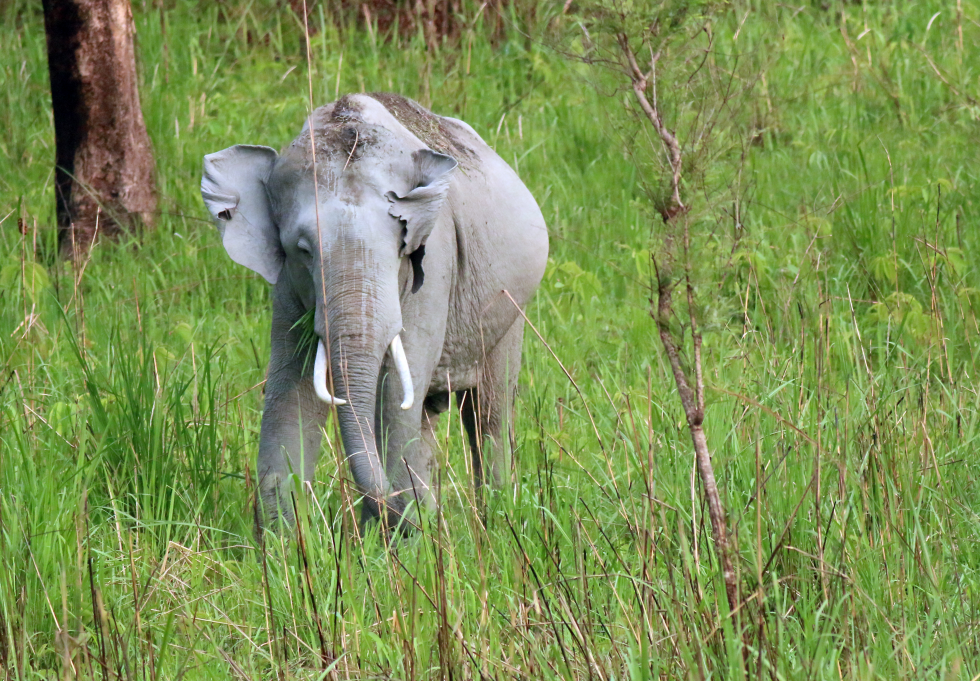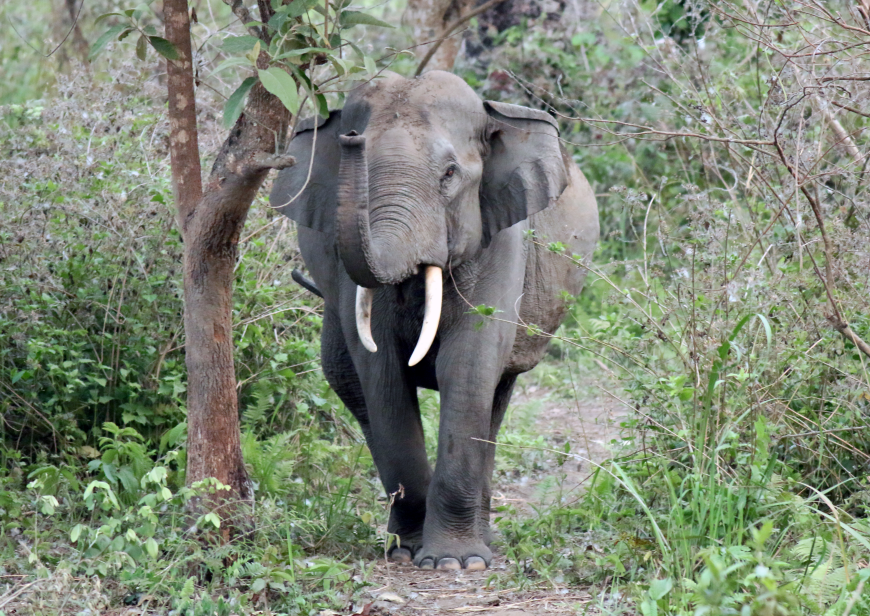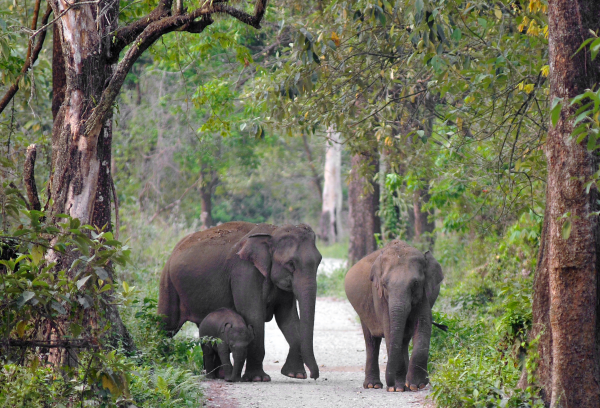














Asian elephants formerly ranged from West Asia along the Iranian coast into the Indian subcontinent, eastwards into South-east Asia including Sumatra, Java, and Borneo, and into China at least as far as the Yangtze-Kiang. This former range covered over 9 million km² (Sukumar 2003). Asian elephants are now extinct in West Asia, Java, and most of China The western populations (Elephas maximus asurus) were probably extinct by 100 BC, and the main Chinese populations (sometimes referred to as E. m. rubridens) disappeared sometime after the 14th century BC. Even within its surviving range in South and South-east Asia, the species has been in retreat for hundreds if not thousands of years, and generally survives only in highly fragmented populations (Olivier 1978; Sukumar 2003; Blake and Hedges 2004).
Once widespread in India, the species is now restricted to four general areas: northeastern India, central India, northwestern India, and southern India. In northeastern India, the elephant range extends from the eastern border of Nepal in northern West Bengal through western Assam along the Himalaya foothills as far as the Mishmi Hills. From here it extends into eastern Arunachal Pradesh, the plains of upper Assam, and the foothills of Nagaland. Further west, it extends to the Garo Hills of Meghalaya through the Khasi Hills, to parts of the lower Brahmaputra plains and Karbi Plateau. Elsewhere in the south in Tripura, Mizoram, Manipur, and the Barak valley districts of Assam, isolated herds occur (Choudhury, 1999). In central India, highly fragmented elephant populations are found in the States of Orissa, Jharkhand, and the southern part of West Bengal, with some animals wandering into Chattisgarh. In north-western India, the species occurs in six fragmented populations at the foot of the Himalayas in Uttaranchal and Uttar Pradesh, ranging from Katerniaghat Wildlife Sanctuary in Bahraich Forest Division in the east, to the Yamuna River in the west. In southern India, elephants occur in the hilly terrain of the Western Ghats and in parts of the Eastern Ghats in the states of Karnataka, Kerala, Tamil Nadu, and, relatively recently, Andhra Pradesh. There are eight main populations in southern India, each fragmented from the others: northern Karnataka; the crestline of Karnataka–Western Ghats; Bhadra–Malnad; Brahmagiri–Nilgiris–Eastern Ghats; Nilambur–Silent Valley–Coimbatore; Anamalais–Parambikulam; Periyar–Srivilliputhur; and Agasthyamalais.
A recent estimate for the global population size of the Asian elephant was 41,410–52,345 animals Sukumar (2003) The estimated population size for each country was: Bangladesh 150–250; Bhutan 250–500; Cambodia 250–600; China 200–250; India 26,390–30,770; Indonesia 2,400–3,400; Lao PDR 500–1,000; Malaysia 2,100–3,100; Myanmar 4,000–5,000; Nepal 100–125; Sri Lanka 2,500–4,000; Thailand 2,500–3,200; and Viet Nam 70–150 (Sukumar, 2003) . However, Blake and Hedges (2004) and Hedges (2006) argue that the oft-repeated global population ‘estimate’ of about 40,000 to 50,000 Asian elephants is no more than a crude guess, which has been accepted unchanged for a quarter of a century. They argue that with very few exceptions all we really know about the status of Asian elephants is the location of some (probably most) populations, with in some cases a crude idea of relative abundance; and for some large parts of the species range we do not even know where the populations are, or indeed if they are still extant. These difference of opinion are due in part to the difficulty in counting elephants in dense vegetation in difficult terrain, different survey techniques being used in different places, and a too-widely held belief that population monitoring is unimportant. Nevertheless, whatever the error margins, it appears almost certain that over 50% of the remaining wild Asian elephants occur in India.
he pre-eminent threats to the Asian elephant today are habitat loss, degradation, and fragmentation (Leimgruber et al., 2003; Sukumar, 2003; Hedges, 2006), which are driven by an expanding human population, and lead in turn to increasing conflicts between humans and elephants when elephants eat or trample crops. Hundreds of people and elephants are killed annually as a result of such conflicts. The long-term future of elephants outside protected areas, as well as in some protected areas, is therefore inextricably linked to mitigating such human–elephant conflicts, and this is one of the largest conservation challenges in Asia today (Sukumar, 1992, 2003; Hedges 2006).
Asian elephants live in the region of the world with the densest human population, growing at a rate of between 1–3% per year. Because elephants require much larger areas of natural habitat than most other terrestrial mammals in Asia, they are one of the first species to suffer the consequences of habitat fragmentation and destruction and because of its great size and large food requirements, the elephant cannot co-exist with people in areas where agriculture is the dominant form of land-use. In extreme cases, elephants have been confined as so called ‘pocketed herds’ in small patches of forest in landscapes dominated by man. Such ‘pocketed herds’ represent an extreme stage in the human–elephant conflict (Olivier, 1978). In other cases elephants have been caught and taken to so-called Elephant Training Centres where they languish, lost to the wild population (Hedges et al., 2005, 2006).
Poaching is a major threat to elephants in Asia too, although reliable estimates of the number of elephants killed and the quantities of ivory and other body parts collected and traded are scarce (Sukumar et al., 1998; Milliken, 2005). It has been argued that poaching is a relatively minor threat to Asian elephant because some males and all females lack tusks (Dawson and Blackburn, 1991). However, the reality is that elephants are poached for a variety of other products (including meat and leather) in addition to ivory, and poaching is now acknowledged as a threat to the long-term survival of some Asian elephant populations (e.g. Kemf and Santiapillai, 2000; Menon, 2002). Moreover, poaching of elephants for ivory is a serious problem in some parts of Asia (Sukumar, 1992; Menon et al., 1997). In Periyar Tiger Reserve in southern India, for example, ivory poaching has dramatically skewed adult sex ratios: over the 20-year period from 1969 to 1989 the adult male:female sex ratio changed from 1:6 to 1:122 (Chandran, 1990). Selective removal of tusked males has several implications for the affected populations: sex ratios obviously become highly female biased, genetic variation is reduced, and fecundity and recruitment may decline (Sukumar et al., 1998; Sukumar, 2003). Poaching of elephants is also a major problem in other parts of Asia. Large-scale hunting of elephants for ivory, bushmeat, hides, and other products has reduced their populations significantly over a wide area from Myanmar to Indonesia (Menon et al., 1997; Duckworth and Hedges, 1998; Kemf and Santiapillai, 2000; Martin and Stiles, 2002; Menon, 2002; World Wide Fund for Nature, 2002a; Hedges et al., 2005).
Asian elephants live in the region of the world with the densest human population, growing at a rate of between 1–3% per year. Because elephants require much larger areas of natural habitat than most other terrestrial mammals in Asia, they are one of the first species to suffer the consequences of habitat fragmentation and destruction and because of its great size and large food requirements, the elephant cannot co-exist with people in areas where agriculture is the dominant form of land-use. In extreme cases, elephants have been confined as so called ‘pocketed herds’ in small patches of forest in landscapes dominated by man. Such ‘pocketed herds’ represent an extreme stage in the human–elephant conflict (Olivier, 1978). In other cases elephants have been caught and taken to so-called Elephant Training Centres where they languish, lost to the wild population (Hedges et al., 2005, 2006).
Poaching is a major threat to elephants in Asia too, although reliable estimates of the number of elephants killed and the quantities of ivory and other body parts collected and traded are scarce (Sukumar et al., 1998; Milliken, 2005). It has been argued that poaching is a relatively minor threat to Asian elephant because some males and all females lack tusks (Dawson and Blackburn, 1991). However, the reality is that elephants are poached for a variety of other products (including meat and leather) in addition to ivory, and poaching is now acknowledged as a threat to the long-term survival of some Asian elephant populations (e.g. Kemf and Santiapillai, 2000; Menon, 2002). Moreover, poaching of elephants for ivory is a serious problem in some parts of Asia (Sukumar, 1992; Menon et al., 1997). In Periyar Tiger Reserve in southern India, for example, ivory poaching has dramatically skewed adult sex ratios: over the 20-year period from 1969 to 1989 the adult male:female sex ratio changed from 1:6 to 1:122 (Chandran, 1990). Selective removal of tusked males has several implications for the affected populations: sex ratios obviously become highly female biased, genetic variation is reduced, and fecundity and recruitment may decline (Sukumar et al., 1998; Sukumar, 2003). Poaching of elephants is also a major problem in other parts of Asia. Large-scale hunting of elephants for ivory, bushmeat, hides, and other products has reduced their populations significantly over a wide area from Myanmar to Indonesia (Menon et al., 1997; Duckworth and Hedges, 1998; Kemf and Santiapillai, 2000; Martin and Stiles, 2002; Menon, 2002; World Wide Fund for Nature, 2002a; Hedges et al., 2005).
Sources: http://www.iucnredlist.org/details/7140/0


